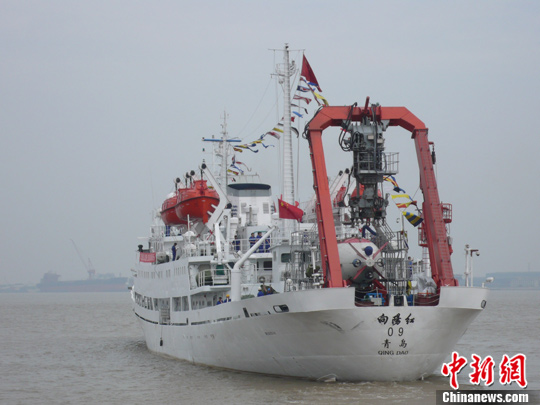(Ecns.cn)--Named after a mythical sea dragon, China's manned deep-diving submersible, the Jiaolong, set off July 1 aboard the "Xiangyanghong 09" for a 5,000-meter dive in the Pacific Ocean. If everything goes well, the vessel will reach the trial area in about 10 days.
As the world's fifth country – following the US, France, Russia and Japan – to develop a manned submersible capable of diving more than 3,500 meters below sea level, China's Jiaolong reached a maximum depth of 3,759 meters during its 17 dives in the South China Sea last year.
Equipment testing and scientific exploration
A submersible is a smaller version of a submarine which depends on a mother ship for support at the surface. The mother ship "Xiangyanghong 09" is also an oceanographic survey vessel which can facilitate scientific exploration.
This time the Jiaolong will spend 47 days at sea, and is expected to make four dives, according to Jin Jiancai, secretary-general of the China Ocean Mineral Resources R&D Association (COMRA).
"The Jiaolong is the first manned deep-diving submersible designed and produced by China," Jin said.
"In the mission, the Jiaolong will attempt to delve 5,000 meters deep, test the performance and function of its equipment, including seafloor photography, topographical and geomorphic measurements, and underwater environmental tests."
Sea beds 4,000 to 6,000 meters down are expected to be rich in deposits of rare metals, methane hydrate and natural gas bound in ice. The Jiaolong is scheduled to evaluate the coverage and abundance of these resources.
Designed for a depth of 7,000 meters
Jin was very proud that China has developed the technology to make a manned submersible dive beyond the 3,500 meter mark.
"Though the manned submersibles of the other four countries can dive to a maximum depth of between 6,000 and 6,500 meters, they usually dive 5,000 meters deep in operation. If our test of 5,000 meters is successful, it means we will have mastered world-level advanced technology, which will lay the foundation for a further 7,000-meter dive test next year," said Jin.
When asked about the choice of the Pacific Ocean between southeastern Hawaii and North America, Jin said it is because the area has a depth between 5,000 and 6,000 meters, which is suitable for the test.
Jin added, "COMRA signed a contract with the International Seabed Authority (ISA) in 2001. With permits from the ISA, China will be able to explore minerals and other resources in the area after the technology matures."
Agile robotic arm
The Jiaolong is 8.2 meters long and weighs about 22 tons. Three crew members work inside a cabin with a radius of only 2.1 meters.
Since the sea is completely dark in areas below 200 meters, sonar systems must be used to judge the environment, and guidance systems are used to determine the direction, height, depth and accurate location of mineral resources.
The Jiaolong's robotic arms can move in an agile manner, achieving the function of human shoulders, elbows and wrists. If the craft becomes trapped, its warning system will launch a buoy to the surface signaling the mother ship for assistance.


















